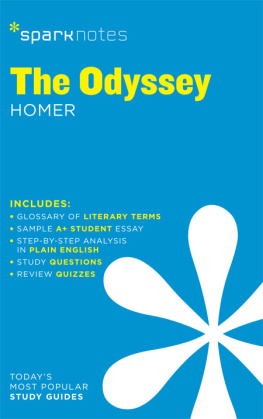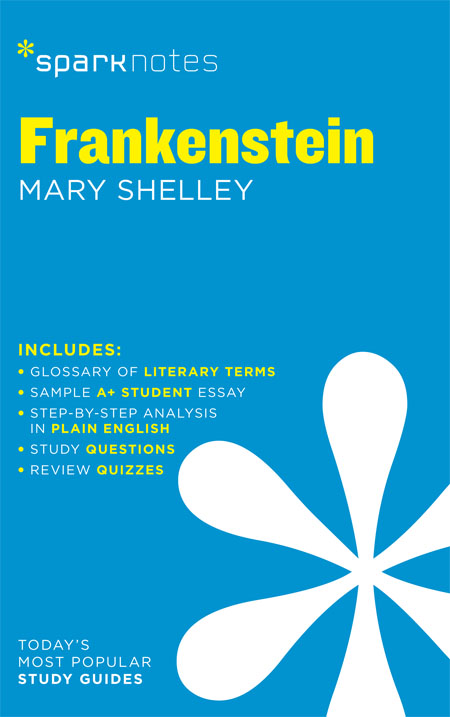Frankenstein
Mary Shelley
2003, 2007 by Spark Publishing
This Spark Publishing edition 2014 by SparkNotes LLC, an Affiliate of Barnes & Noble
All rights reserved. No part of this publication may be reproduced, stored in a retrieval system, or transmitted in any form or by any means (including electronic, mechanical, photocopying, recording, or otherwise) without prior written permission from the publisher.
Sparknotes is a registered trademark of SparkNotes LLC
Spark Publishing
A Division of Barnes & Noble
120 Fifth Avenue
New York, NY 10011
www.sparknotes.com /
ISBN-13: 978-1-4114-7160-3
Please submit changes or report errors to www.sparknotes.com/errors.
10 9 8 7 6 5 4 3 2 1
Context
Did I request thee, Maker, from my clay
To mould me Man, did I solicit thee
From darkness to promote me?
(See )
I n the summer of 1816 , a young, well-educated woman from England traveled with her lover to the Swiss Alps. Unseasonable rain kept them trapped inside their lodgings, where they entertained themselves by reading ghost stories. At the urging of renowned poet Lord Byron, a friend and neighbor, they set their own pens to paper, competing to see who could write the best ghost story. The young woman, Mary Wollstonecraft Godwin, took the prize, having composed a story creepy enough not only to take its place alongside the old German tales that she and her Alpine companions had been reading, but also to become a bestseller in her time and a Gothic classic that still resonates with readers almost two centuries later.
Mary Wollstonecraft Godwin was born on August 30, 1797, in London, of prime literary stock. Her mother, Mary Wollstonecraft, was the author of A Vindication of the Rights of Woman, a feminist tract encouraging women to think and act for themselves. Wollstonecraft died giving birth to Mary, leaving her daughter in the care of her husband, William Godwin, a member of a circle of radical thinkers in England that counted Thomas Paine and William Blake among its ranks. Marys upbringing in this rarefied atmosphere exposed her at an early age to cutting-edge ideas, and it forged useful connections for her to such notables as Lord Byron.
Another of the literary types that Mary met as a teenager was Percy Bysshe Shelley, a dashing young poet. Sparks flew, and, in 1814 , they ran away together for a tour of France, Switzerland, and GermanyMary escaping her family and Percy his wife. At first blissful, their affair soon came under strain. Percys relationship with Mary waxed and waned with the demands of his wife, Harriet; meanwhile, Mary busied herself with another man. Despite these distractions, the relationship endured and was eventually formalized under scandalous circumstances: Harriet, pregnant with Percys child, drowned herself in London in November of 1816 ; Mary and Percy were married weeks later.
The union between Mary and Percy was not only romantic but also literary. Percy edited Marys manuscript for Frankenstein and is commonly supposed to have written the preface under her name. Frankenstein was published on January 1, 1818 , and became an immediate bestseller. Unfortunately for Mary, this success was a single bright spot amid a series of tragedies. From 1815 to 1819 , three of her four children died in infancy; in 1822 , Percy drowned off the shore of Tuscany, leaving Mary a widow and single mother. Mary turned to her husbands poetry and prose, editing and publishing his Posthumous Poems in 1824 and his Poetical Works and Letters in 1839 . She spent the rest of her time on her own writing, publishing Valperga in 1823 , The Last Man in 1826 , The Fortunes of Perkin Warbeck in 1830 , Lodore in 1835 , and Falkner in 1837 . Serious illness plagued Mary, and she died in London in February 1851 .
Plot Overview
I n a series of letters, Robert Walton, the captain of a ship bound for the North Pole, recounts to his sister back in England the progress of his dangerous mission. Successful early on, the mission is soon interrupted by seas full of impassable ice. Trapped, Walton encounters Victor Frankenstein, who has been traveling by dog-drawn sledge across the ice and is weakened by the cold. Walton takes him aboard ship, helps nurse him back to health, and hears the fantastic tale of the monster that Frankenstein created.
Victor first describes his early life in Geneva. At the end of a blissful childhood spent in the company of Elizabeth Lavenza (his cousin in the 1818 edition, his adopted sister in the 1831 edition) and friend Henry Clerval, Victor enters the university of Ingolstadt to study natural philosophy and chemistry. There, he is consumed by the desire to discover the secret of life and, after several years of research, becomes convinced that he has found it.
Armed with the knowledge he has long been seeking, Victor spends months feverishly fashioning a creature out of old body parts. One climactic night, in the secrecy of his apartment, he brings his creation to life. When he looks at the monstrosity that he has created, however, the sight horrifies him. After a fitful night of sleep, interrupted by the specter of the monster looming over him, he runs into the streets, eventually wandering in remorse. Victor runs into Henry, who has come to study at the university, and he takes his friend back to his apartment. Though the monster is gone, Victor falls into a feverish illness.
Sickened by his horrific deed, Victor prepares to return to Geneva, to his family, and to health. Just before departing Ingolstadt, however, he receives a letter from his father informing him that his youngest brother, William, has been murdered. Grief-stricken, Victor hurries home. While passing through the woods where William was strangled, he catches sight of the monster and becomes convinced that the monster is his brothers murderer. Arriving in Geneva, Victor finds that Justine Moritz, a kind, gentle girl who had been adopted by the Frankenstein household, has been accused. She is tried, condemned, and executed, despite her assertions of innocence. Victor grows despondent, guilty with the knowledge that the monster he has created bears responsibility for the death of two innocent loved ones.
Hoping to ease his grief, Victor takes a vacation to the mountains. While he is alone one day, crossing an enormous glacier, the monster approaches him. The monster admits to the murder of William but begs for understanding. Lonely, shunned, and forlorn, he says that he struck out at William in a desperate attempt to injure Victor, his cruel creator. The monster begs Victor to create a mate for him, a monster equally grotesque to serve as his sole companion.
Victor refuses at first, horrified by the prospect of creating a second monster. The monster is eloquent and persuasive, however, and he eventually convinces Victor. After returning to Geneva, Victor heads for England, accompanied by Henry, to gather information for the creation of a female monster. Leaving Henry in Scotland, he secludes himself on a desolate island in the Orkneys and works reluctantly at repeating his first success. One night, struck by doubts about the morality of his actions, Victor glances out the window to see the monster glaring in at him with a frightening grin. Horrified by the possible consequences of his work, Victor destroys his new creation. The monster, enraged, vows revenge, swearing that he will be with Victor on Victors wedding night.
Later that night, Victor takes a boat out onto a lake and dumps the remains of the second creature in the water. The wind picks up and prevents him from returning to the island. In the morning, he finds himself ashore near an unknown town. Upon landing, he is arrested and informed that he will be tried for a murder discovered the previous night. Victor denies any knowledge of the murder, but when shown the body, he is shocked to behold his friend Henry Clerval, with the mark of the monsters fingers on his neck. Victor falls ill, raving and feverish, and is kept in prison until his recovery, after which he is acquitted of the crime.
















